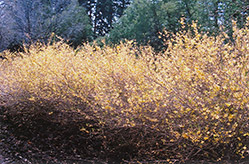Plant Library
Height: 6 feet
Spread: 6 feet
Sunlight:
![]()
Hardiness Zone: 3a
Other Names: Goldenbells
Description:
Striking gold flowers smother the branches in early spring ahead of the leaves, a harbinger of spring; more of a utility shrub the rest of the season, makes a fine screen or hedge
Ornamental Features
Early Forsythia is smothered in stunning gold bell-shaped flowers along the branches in early spring before the leaves. The flowers are excellent for cutting. It has forest green deciduous foliage. The pointy leaves do not develop any appreciable fall colour.
Landscape Attributes
Early Forsythia is a multi-stemmed deciduous shrub with an upright spreading habit of growth. Its average texture blends into the landscape, but can be balanced by one or two finer or coarser trees or shrubs for an effective composition.
This is a relatively low maintenance shrub, and should only be pruned after flowering to avoid removing any of the current season's flowers. Deer don't particularly care for this plant and will usually leave it alone in favor of tastier treats. It has no significant negative characteristics.
Early Forsythia is recommended for the following landscape applications;
- Mass Planting
- Hedges/Screening
- General Garden Use
Planting & Growing
Early Forsythia will grow to be about 6 feet tall at maturity, with a spread of 6 feet. It tends to fill out right to the ground and therefore doesn't necessarily require facer plants in front, and is suitable for planting under power lines. It grows at a fast rate, and under ideal conditions can be expected to live for 40 years or more.
This shrub should only be grown in full sunlight. It is very adaptable to both dry and moist locations, and should do just fine under average home landscape conditions. It is not particular as to soil type or pH, and is able to handle environmental salt. It is highly tolerant of urban pollution and will even thrive in inner city environments. This species is not originally from North America.


